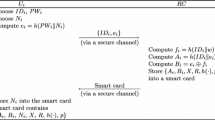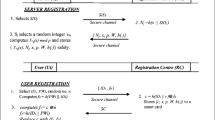Abstract
The recent technological advancement and rapid development of computer networks have increased the popularity of remote password authentication protocols. Toward this end, the emphasis has shifted to protocols that apply to smart cards-empowered multi-server environments. In order to defend against the replay attack, these protocols usually depend on the nonce or timestamp. In this paper, an efficient Mittag–Leffler–Chebyshev Summation Chaotic Map (MLCSCM)-enabled multi-server authentication protocol with the key agreement is proposed and generalized to address this peculiarity in multi-server-oriented applications. The security proof and efficiency analysis of the presented MLCSCM authenticated key agreement protocol is rigorously derived and validated. Compared to the recently published literature, the proposed protocol presents high efficiency with unique features, and it is highly resistant to sophisticated attacks and achieves perfect forward secrecy.





Similar content being viewed by others
References
Wang Y, Li C, Khan MA, Li N, Yuan R (2021) Firm information disclosure environment and R&D investment: evidence from Internet penetration. PLoS ONE 16(3):1–20. https://doi.org/10.1371/journal.pone.0247549
Gannon DB, Rosendale V (1984) On the impact of communication complexity on the design of parallel numerical algorithms. IEEE Trans Comput 33(12):1180–1194. https://doi.org/10.1109/TC.1984.1676393
Li CT, Lee CC (2011) A robust remote user authentication scheme using smart card. Inf Technol Control 40(3):236–245. https://doi.org/10.5755/j01.itc.40.3.632
Li CT, Lee CC, Weng CY, Fan CI (2013) An extended multi-server-based user authentication and key agreement scheme with user anonymity. KSII Trans Internet Inf Syst 7(1):119–131. https://doi.org/10.3837/tiis.2013.01.008
Menkus B (1988) Understanding the use of passwords. Comput Secur 7(2):132–136. https://doi.org/10.1016/0167-4048(88)90325-2
Tsaur W-J, Li J-H, Lee W-B (2012) An efficient and secure multi-server authentication scheme with key agreement. J Syst Softw 85(4):876–882. https://doi.org/10.1016/j.jss.2011.10.049
Kohl JT, Neuman BC, Theodore Y (1991) The evolution of the Kerberos authentication service. In: European Conf. Proc., pp 295–313
Tsai J-L (2008) Efficient multi-server authentication scheme based on one-way hash function without verification table. Comput Secur 27(3):115–121. https://doi.org/10.1016/j.cose.2008.04.001
Zhu H (2015) A provable one-way authentication key agreement scheme with user anonymity for multi-server environment. KSII Trans Internet Inf Syst 9(2):811–828. https://doi.org/10.3837/tiis.2015.02.019
Lee C-C, Lou D-C, Li C-T, Hsu C-W (2014) An extended chaotic-maps-based protocol with key agreement for multiserver environments. Nonlinear Dyn 76(1):853–866. https://doi.org/10.1007/s11071-013-1174-3
Banerjee S, Dutta MP, Bhunia CT (2015) An improved smart card based anonymous multi-server remote user authentication scheme. Int J Smart Home 9(5):11–22. https://doi.org/10.14257/ijsh.2015.9.5.02
Sun Q, Moon J, Choi Y, Won D (2016) An improved dynamic ID based remote user authentication scheme for multi-server environment. In: Huang X, Xiang Y, Li K-C (eds) Green, pervasive, and cloud computing. Springer, Cham, pp 229–242
Li X et al (2016) A novel chaotic maps-based user authentication and key agreement protocol for multi-server environments with provable security. Wirel Pers Commun 89(2):569–597. https://doi.org/10.1007/s11277-016-3293-x
Irshad A et al (2018) An enhanced and provably secure chaotic map-based authenticated key agreement in multi-server architecture. Arab J Sci Eng 43(2):811–828. https://doi.org/10.1007/s13369-017-2764-z
Jangirala S, Mukhopadhyay S, Das AK (2017) A multi-server environment with secure and efficient remote user authentication scheme based on dynamic ID using smart cards. Wirel Pers Commun 95(3):2735–2767. https://doi.org/10.1007/s11277-017-3956-2
Ying B, Nayak A (2019) Lightweight remote user authentication protocol for multi-server 5G networks using self-certified public key cryptography. J Netw Comput Appl 131:66–74. https://doi.org/10.1016/j.jnca.2019.01.017
Meshram C, Obaidat MS, Tembhurne JV, Shende SW, Kalare KW, Meshram SG (2020) A lightweight provably secure digital short-signature technique using extended chaotic maps for human-centered IoT systems. IEEE Syst J. https://doi.org/10.1109/JSYST.2020.3043358
Meshram C, Ibrahim RW, Obaid AJ, Meshram SG, Meshram A, El-Latif AMA (2020) Fractional chaotic maps based short signature scheme under human-centered IoT environments. J Adv Res. https://doi.org/10.1016/j.jare.2020.08.015
Meshram C, Lee CC, Meshram SG, Meshram A (2020) OOS-SSS: an efficient online/offline subtree-based short signature scheme using Chebyshev chaotic maps for wireless sensor network. IEEE Access 8:80063–80073. https://doi.org/10.1109/ACCESS.2020.2991348
Meshram C, Li C-T, Meshram SG (2019) An efficient online/offline ID-based short signature procedure using extended chaotic maps. Soft Comput 23(3):747–753. https://doi.org/10.1007/s00500-018-3112-2
Meshram C, Ibrahim RW, Deng L, Shende SW, Meshram SG, Barve SK (2021) A robust smart card and remote user password-based authentication protocol using extended chaotic maps under smart cities environment. Soft Comput 25(15):10037–10051. https://doi.org/10.1007/s00500-021-05929-5
Meshram C, Obaidat MS, Meshram A (2020) An efficient robust lightweight remote user authentication protocol using extended chaotic maps. In: Proceedings of 2020 International Conference on Computer, Information and Telecommunication Systems CITS 2020, pp 8–13. https://doi.org/10.1109/CITS49457.2020.9232622
Datta D et al (2021) An efficient sound and data steganography based secure authentication system. Comput Mater Contin 67(1):723–751. https://doi.org/10.32604/cmc.2021.014802
Meshram C, Lee CC, Ranadive AS, Li CT, Meshram SG, Tembhurne JV (2020) A subtree-based transformation model for cryptosystem using chaotic maps under cloud computing environment for fuzzy user data sharing. Int J Commun Syst 33(7):1–15. https://doi.org/10.1002/dac.4307
Meshram C, Lee C-C, Meshram SG, Li C-T (2019) An efficient ID-based cryptographic transformation model for extended chaotic-map-based cryptosystem. Soft Comput 23(16):6937–6946. https://doi.org/10.1007/s00500-018-3332-5
Meshram C, Ibrahim RW, Obaidat MS, Sadoun B, Meshram SG, Tembhurne JV (2021) An effective mobile-healthcare emerging emergency medical system using conformable chaotic maps. Soft Comput 25(14):8905–8920. https://doi.org/10.1007/s00500-021-05781-7
Gaikwad VP, Tembhurne JV, Meshram C, Lee C-C (2021) Provably secure lightweight client authentication scheme with anonymity for TMIS using chaotic hash function. J Supercomput. https://doi.org/10.1007/s11227-020-03553-y
Kumar P et al (2021) PPSF: a privacy-preserving and secure framework using blockchain-based machine-learning for IoT-driven smart cities. IEEE Trans Netw Sci Eng. https://doi.org/10.1109/TNSE.2021.3089435
Wang W, Xu H, Alazab M, Gadekallu TR, Han Z, Su C (2021) Blockchain-based reliable and efficient certificateless signature for IIoT devices. IEEE Trans Ind Inform. https://doi.org/10.1109/TII.2021.3084753
Shunmuganathan S, Saravanan RD, Palanichamy Y (2015) Secure and efficient smart-card-based remote user authentication scheme for multiserver environment. Can J Electr Comput Eng 38(1):20–30. https://doi.org/10.1109/CJECE.2014.2344447
Mason JC, Handscomb DC (2002) Chebyshev polynomials. CRC Press
Bergamo P, D’Arco P, De Santis A, Kocarev L (2005) Security of public-key cryptosystems based on Chebyshev polynomials. IEEE Trans Circuits Syst I Regul Pap 52(7):1382–1393. https://doi.org/10.1109/TCSI.2005.851701
Haubold HJ, Mathai AM, Saxena RK (2011) Mittag–Leffler functions and their applications. J Appl Math 2011:298628. https://doi.org/10.1155/2011/298628
Rahman G, Baleanu D, Al Qurashi M, Purohit SD, Mubeen S, Arshad M (2017) The extended Mittag–Leffler function via fractional calculus. J Nonlinear Sci Appl 10(8):4244–4253. https://doi.org/10.2243/jnsa.010.08.19
Rashid S, Sultana S, Hammouch Z, Jarad F, Hamed YS (2021) Novel aspects of discrete dynamical type inequalities within fractional operators having generalized ℏ-discrete Mittag–Leffler kernels and application. Chaos Solitons Fractals 151:111204. https://doi.org/10.1016/j.chaos.2021.111204
Han S, Chang E (2009) Chaotic map based key agreement with/out clock synchronization. Chaos Solitons Fractals 39(3):1283–1289. https://doi.org/10.1016/j.chaos.2007.06.030
Lee C-C, Hsu C-W (2013) A secure biometric-based remote user authentication with key agreement scheme using extended chaotic maps. Nonlinear Dyn 71(1):201–211. https://doi.org/10.1007/s11071-012-0652-3
Zhang L (2008) Cryptanalysis of the public key encryption based on multiple chaotic systems. Chaos Solitons Fractals 37(3):669–674. https://doi.org/10.1016/j.chaos.2006.09.047
Burrows M, Abadi M, Needham R (1990) A logic of authentication. ACM Trans Comput Syst 8(1):18–36. https://doi.org/10.1145/77648.77649
Wessels J (2001) Applications of Ban-logic. CMG FINANCE BV 19:1–23
He D, Chen Y, Chen J (2012) Cryptanalysis and improvement of an extended chaotic maps-based key agreement protocol. Nonlinear Dyn 69(3):1149–1157. https://doi.org/10.1007/s11071-012-0335-0
He D, Ma M, Zhang Y, Chen C, Bu J (2011) A strong user authentication scheme with smart cards for wireless communications. Comput Commun 34(3):367–374. https://doi.org/10.1016/j.comcom.2010.02.031
Meshram C, Powar PL (2016) An efficient identity-based QER cryptographic scheme. Complex Intell Syst 2(4):285–291. https://doi.org/10.1007/s40747-016-0030-8
Acknowledgements
The authors would like to thank the anonymous reviewers of the Journal of Supercomputing for their excellent reviews and helpful commentsand extend their gratitude to the Deanship of Scientific Research at King Khalid University for funding this work through research groups program under grant number R. G. P. 1/72/42. Agbotiname Lucky Imoize is partly supported by the Nigerian Petroleum Technology Development Fund (PTDF) and the German Academic Exchange Service (DAAD) through the Nigerian-German Postgraduate Program under Grant 57473408.
Author information
Authors and Affiliations
Contributions
CM and RWI conceived the study; ALI contributed to formal analysis; CM, RWI, and SSJ contributed to investigation, methodology, supervision, validation/visualization, and writing—original draft; CM contributed to resources; SGM and ALI contributed to software; CM, RWI, SSJ, SGM, and ALI performed writing—review & editing.
Corresponding author
Ethics declarations
Conflict of interest
The authors have declared no conflict of interest.
Human and animal rights
This article does not contain any studies with human or animal subjects.
Additional information
Publisher's Note
Springer Nature remains neutral with regard to jurisdictional claims in published maps and institutional affiliations.
Rights and permissions
About this article
Cite this article
Meshram, C., Ibrahim, R.W., Meshram, S.G. et al. An efficient authentication with key agreement procedure using Mittag–Leffler–Chebyshev summation chaotic map under the multi-server architecture. J Supercomput 78, 4938–4959 (2022). https://doi.org/10.1007/s11227-021-04039-1
Accepted:
Published:
Issue Date:
DOI: https://doi.org/10.1007/s11227-021-04039-1




